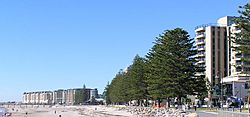Holdfast Bay facts for kids
Quick facts for kids Holdfast Bay |
|
|---|---|

Looking north along the beach at Holdfast Bay to Glenelg
|
|
| Location | Gulf St Vincent, South Australia |
| Coordinates | 34°58′16″S 138°30′29″E / 34.97103°S 138.508099°E |
| Type | Bay |
| Primary outflows | Gulf St Vincent |
| Basin countries | Australia |
| Frozen | never |
| Settlements | Glenelg, Glenelg North |
Holdfast Bay is a small bay in South Australia. It's right next to the city of Adelaide. This bay is part of a bigger body of water called Gulf St Vincent.
Along the shores of Holdfast Bay, you'll find the local government area known as the City of Holdfast Bay. The popular suburbs of Glenelg and Glenelg North are also located here.
Contents
Holdfast Bay: A Place of Early Settlement
Holdfast Bay got its name in 1836 from Colonel William Light. He was the surveyor general for South Australia. He wrote in his journal how happy he was with how well ships could anchor there, even during a storm.
This bay was a very important spot in 1836 and 1837. It was where the first pioneers landed to start the colony of South Australia.
The First Arrivals
On November 8, 1836, Robert Gouger arrived at Holdfast Bay. He was the Colonial Secretary and Chief Magistrate. He came on a ship called the Africaine. His group set up camp near a famous spot called The Old Gum Tree.
Then, on December 28, Governor Hindmarsh arrived. This day was special because it was Proclamation Day. The new colony of South Australia was officially announced. The settlement at Holdfast Bay became the first place where the government of South Australia was based. It stayed the government's home until March 1837.
Just a few days later, on December 31, 1836, the Holdfast Bay settlement was renamed Glenelg. Later, in 1855, the Corporate Town of Glenelg was created. This group helped manage the town and its surrounding areas. It later became known as the City of Glenelg.
Exploring Holdfast Bay: Diving and Snorkeling
Holdfast Bay is a great place for diving and snorkeling. It has both natural and man-made underwater areas. These spots are perfect for exploring the ocean.
Man-Made Underwater Reefs
You can swim from the shore to reach a few interesting spots. These include the Brighton Jetty, the Glenelg Jetty, and a place called The Blocks. You can also easily reach The Blocks by kayak.
- The Blocks: This used to be a maritime structure. It's a series of concrete and steel columns. Now, it acts like a broken wall that helps stop waves. It's also a home for sea creatures. You might see seahorses and pipefish here.
- Glenelg Tyre Reef: In 1983, a reef was made using old tires shaped like pyramids. Today, it's starting to break down. It's about 5 kilometers west of Glenelg and is 18 meters deep.
- Scuttled Ships: Two ships were sunk on purpose in Holdfast Bay. They are the Glenelg barge and the South Australian. People often call the South Australian "The Dredge." Both ships are about 15 to 20 meters deep. Divers can explore these old shipwrecks.
Natural Underwater Reefs
Holdfast Bay also has several natural reefs. These reefs are at different depths, from 8 to 24 meters.
- Devil's Elbow: This is a unique reef that's 8 to 10 meters deep. It's known for its interesting shape where two rocky shelves meet. You can find giant Australian cuttlefish and many types of nudibranchs here.
- Fred's Rock: This rock is 24 meters deep. Some people think it might be a meteorite! It's part of a larger area called Fred's Ground. Fish like pelagic fish often swim in schools above it.
- Leatherjacket Alley: This natural reef is about 2 kilometers northwest of Glenelg and 10 meters deep. It has natural channels and is popular with many species of leatherjacket fish.
- Mac's Ground: This is a small reef about 4.5 kilometers west of Glenelg. It's 17 meters deep and rises about one meter from the seabed. It's 150 meters long and has cool overhangs and a small cave.
- Milkie's Reef: This natural reef is not visited very often. It's 4.5 kilometers southwest of Glenelg and 17 meters deep. It's known for having lots of spider crabs and a huge variety of fish.
- Northern Outer Reef: This reef is part of an old shoreline. It's 18 to 22 meters deep and about 100 meters long. It has rocky ledges and overhangs. Many large sponges grow here. It's also thought to be a place where Western blue devils come to grow.
- Oliver's Reef: This reef is offshore from Glenelg. It's 18 meters deep and has rocky areas. You can find a large purple stony coral here that's about 2 meters wide.
- Seacliff Reef: This natural reef is what's left of a shoreline from 10,000 years ago. The seabed is 12 to 15 meters deep, and the reef rises about a meter above it. It's home to the largest known group of Western blue devils near Adelaide.


